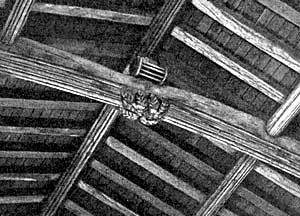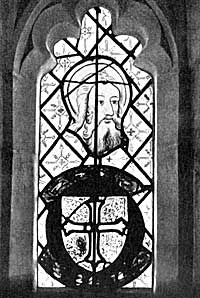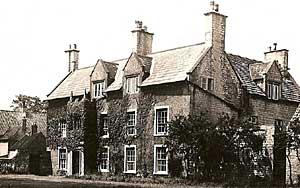
Plate V. Warsop church. Chancel roof, shewing "squirrel-cage" pulley.
A feature of remarkable interest is preserved in the roof. On the eastern face of one of the tie beams there is to be seen a “squirrel-cage” pulley, arranged to work on an iron spindle fixed to the short king-post. [Plate V.] The side of the tie-beam is slightly cut away to allow a suspending cord, or more probably a flat leather band, to run over the pulley. Its position, 15ft. or one bay from the chancel arch, and 30ft. from the east wall, seems too far westward for the hanging pyx, the vessel for the reservation of the Blessed Sacrament, which was hung above the high altar. The roller therefore was probably for the suspension of a light, or a corona of lights, hanging by means of a counterpoise in the middle of the chancel stalls.
There are two doorways near the middle of the south side of the chancel: The westernmost, now blocked up, was a priest's door, and the other leads into a narrow chamber or vestry, already mentioned as having been built at the end of the 15th century, as an addition against the south wall of the chancel, and extending nearly the length of the two eastern bays. The purpose of this building is not clear; there is no evidence of its having been a mortuary chapel, and there was originally no entrance to it from the outside. It was probably intended as a vestry.

Plate VI. Warsop church. 14th century glass in vestry.
In the windows of this chamber some interesting fragments of glass have been inserted for preservation, said to have been taken from the 15th century east window. It is, however, chiefly 14th century glass. There is a head of a female saint, with yellow-stained hair, and a portion of a nimbus with side locks from another figure. Also two other bearded heads, one with a curious brimmed hat being of later date. Here also is a fine specimen of heraldic glass of the 14th century, with the Lexington arms, argent a cross paty azure, the field of white glass beautifully diapered.1 [Plate VI.] This shield is also used by Sutton, as at Averham.2 The manor and advowson of Warsop passed about 1260 from Lexington to Sutton, who held it until 1329, which fixes the latest limit of date for this heraldic glass.
There are four bells, with these inscriptions :
1. S. MIDWORTH • MANSFIELD • 1812 [Note D].
2. GOD BE OVR SPEED • 1747 [Note C].
3. UT TUBA SIC SONITU DOMINI CONDUCO COHORTES • 1615 (Henry Oldfield's shield). [Note B].
4. YOU THAT HEAR MY DOLEFUL SOUND REPENT BEFORE YOURE LAID IN GROUND • OCTOBER 14, 1737. [Note A. Weight about 7 cwt.]
In connection with the Warsop bells it may be mentioned that a memorandum, in the oldest register book of the parish, records an agreement between the inhabitants of Warsop and the inhabitants of the Hamlet of Sokeholme, in 1626, to the effect that in return for seats appointed to them in Warsop church, “the Soukeholme men shall paye to the churchwardens of Warsoppe the fourth part of all charges to wind and weather, and to the keeping of the bells in repayre.”
The church plate of Warsop consists of a chalice and paten of 1718-9, and flagon, alms-dish, and paten, inscribed “The gift of John Kirke of Warsop 1768,” all of silver. There are also a flagon and alms-bason of pewter. In addition there are a highly ornamented silver flagon and chalice inscribed “Presented to the Church of S. Peter and S. Paul, by Rev Sir Richard Fitz Herbert, Bart, 1891.”
There are no medieval monuments remaining in this church except one much decayed floor-slab of 1512, now fixed to the wall of the tower. It shows traces of an incised cross, and the following inscription round the edge:
![]()
There is a fine brass tablet to Oliver Dand, 1661, a loyalist rector during the Commonwealth; an interesting marble tablet to John Rolleston, 1681, the trusted secretary of the Duke of Newcastle, famous in the Civil war; and several tablets of the 18th century to the family of Wyld of Nettleworth in this parish.

The Old Rectory, Warsop, in the 1930s.
The rectory is a charming residence near the east end of the church, rebuilt or enlarged towards the end of the 17th century, possibly by George Fothergill, rector 1663-1683, whose son Thomas succeeded him. Both these rectors are commemorated by brass tablets, the earlier one having very fine lettering.
I must express my thanks to the Rev. R. J. King, rector, for much assistance, and for his interesting pamphlet, Warsop Church Registers, 1884.
The next place to be visited was Norton Cuckney. The vicar, the Rev. J. W. Smith, M.A., kindly read a paper he had prepared regarding the church here, which is dedicated to St. Mary.
(1) I prefer to describe the charge simply as a cross paty, according to the pre-Tudor heralds, rather than by any of the terms invented later for the various ways of drawing a splayed cross.
(2) Transactions of the Thoroton Society, 1913, p. 34.
